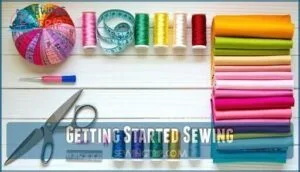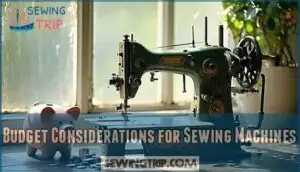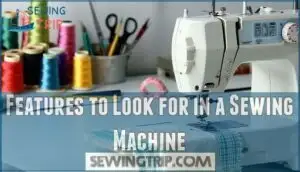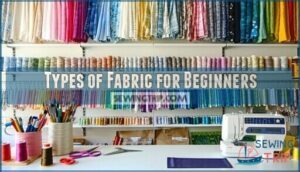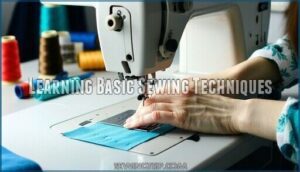This site is supported by our readers. We may earn a commission, at no cost to you, if you purchase through links.
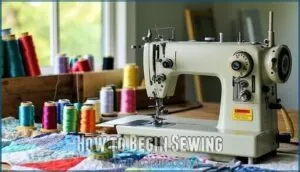
Start with a simple hand-sewing project like a pillowcase or tote bag before investing in a machine. Choose medium-weight cotton fabrics that don’t slip or stretch.
Practice straight stitches on scrap fabric first – everyone’s first seam looks like a roller coaster ride! Thread your needle, knot the end, and work small stitches of consistent size and spacing.
Don’t rush the process – sewing rewards patience. The skills you’ll develop transform from basic repairs to creating personalized garments that perfectly match your style and budget, allowing you to make basic repairs and enjoy the process of creating something.
Table Of Contents
Key Takeaways
- Start with basic tools like needles, thread, fabric scissors, and a measuring tape.
- Practice straight stitches on scrap fabric to build confidence before starting projects.
- Choose beginner-friendly fabrics like cotton that are easy to handle and forgiving of mistakes.
- Focus on simple projects like pillowcases or tote bags to learn foundational skills.
Getting Started Sewing
Starting to sew is all about having the right tools and a simple plan. Begin with basic supplies like a needle, thread, scissors, and some fabric to practice stitching techniques.
Essential Sewing Tools and Supplies
Starting with essential sewing tools saves time and frustration.
You’ll need these basics:
- Fabric scissors: A must for clean cuts.
- Measuring tape: Accurate measurements are key.
- Seam ripper: Mistakes happen—this tool helps.
- Iron: Proper pressing improves results.
Consider tool maintenance and ergonomic options.
High quality scissors offer superior cutting performance.
Storing tools neatly boosts efficiency and keeps sewing enjoyable.
Basic Sewing Tools for Beginners
You’ll need a few basics to get started: fabric scissors, sewing needles, pins, and a measuring tape.
For sewing basics, consider ergonomic tools to ease strain. A seam ripper is your best friend for mistakes, so don’t skip it.
Budget options work fine—tool upgrades can wait. Explore options for essential starter kits to simplify your initial purchases.
Keep everything organized with simple storage solutions for stress-free beginner sewing!
Acquiring a Sewing Machine
A domestic sewing machine opens up endless possibilities.
New budget machines come packed with features, but used machines or rentals are great for learning without overspending.
Explore local shops for hands-on practice or go online for deals. Focus on practical sewing machine features like zigzag stitches.
With proper setup and maintenance, even a basic model can last years.
How to Begin Sewing
Embarking on sewing can feel like stepping into a world of endless possibilities. With the tools in hand from the previous section, it’s time to focus on techniques and building confidence.
A Sewing Mindset is about patience and practice—don’t worry about mistakes; they’re part of Skill Progression. Start small; even hand sewing teaches control. Mastering basic sewing machine skills is essential for beginners.
Here are a few tips:
- Plan simple beginner sewing projects like napkins or tote bags.
- Practice straight stitches on scrap fabric; it’s the foundation of sewing.
- Explore Learning Resources like online tutorials or sewing books for guidance.
- Experiment with both hand sewing and your sewing machine to find your rhythm.
With Creative Exploration and step-by-step Project Planning, you’ll stitch your way to success.
Choosing Sewing Machine
You’ll need to choose between a simple machine with basic stitches for beginners or one with more features that you can grow into as your skills improve.
When shopping, consider your budget, the types of projects you want to make, and whether buying locally with lessons or online for better prices makes more sense for you.
Budget Considerations for Sewing Machines
Now that you’re ready to start sewing, let’s talk money. Sewing machines range from $50 to $15,000, so figure out your budget first.
Basic models work fine for beginners, but spending a bit more means less frustration.
Don’t overlook thrifting machines from garage sales or borrowing machines from friends. Used machines can cost as little as $10, making this hobby accessible for everyone.
Features to Look for in a Sewing Machine
When shopping for your first sewing machine, focus on features that will grow with your skills. You don’t need all the bells and whistles, just the right ones for your projects.
- Strong motor power for handling multiple fabric layers
- Various stitch options including straight, zigzag, and buttonhole stitches
- Foot compatibility for specialized tasks like zippers or buttonholes
- Adjustable speed control for learning at your own pace
Considering different models will help you understand available machine features. This step is crucial for finding a machine that meets your sewing needs and has the right features for your projects, allowing you to work with multiple fabric layers.
Where to Buy a Sewing Machine
Now that you understand what features you need, let’s talk about where to find your perfect sewing machine. You’ve got several buying options, each with their own pros and cons.
| Option | Pros | Cons |
|---|---|---|
| Local Shops | Hands-on testing, expert advice | Higher prices |
| Online Retailers | Better deals, wider selection | Can’t test before buying |
| Used/Thrifted | Budget-friendly, often sturdy | May need servicing |
Many beginners find great budget machines online, but don’t overlook local stores where you can test features firsthand. Some offer sewing machine classes for beginners to learn about sewing machine basics and get expert advice.
Selecting Fabric and Supplies
You’ll want to choose the right fabric and gather essential supplies before starting any sewing project.
For beginners, woven fabrics like cotton and linen are easier to work with, and you’ll need basic items like fabric scissors, pins, measuring tape, and thread that matches your fabric.
Types of Fabric for Beginners
Now that you’ve selected your sewing machine, let’s talk about which fabrics will make your learning curve smoother.
Choosing the right fabric can be the difference between enjoyment and frustration.
Here are 5 beginner-friendly fabric types:
- Cotton – Stable, easy to press, and affordable
- Linen – Natural, environmentally friendly, and holds shape well
- Chambray – Lightweight cotton that cuts and sews easily
- Flannel – Soft with a looser weave, making mistakes easier to fix
- Rayon – Soft and comfortable but requires gentle handling
Consider fabric weight and GSM for your project to guarantee it’s neither too bulky nor too flimsy.
Where to Buy Fabric and Supplies
Now that you’ve learned about beginner-friendly fabrics, let’s find out where to get them.
You can buy fabric and supplies from various sources depending on your budget and preferences.
| Source Type | Pros | Cons |
|---|---|---|
| Local fabric shops | Hands-on fabric testing, immediate purchase, expert advice | Higher prices, limited selection |
| Online fabric stores | Wider selection, competitive pricing, convenience | Can’t feel fabric before buying |
| Thrift stores | Budget-friendly, sustainable fabric sourcing | Hit-or-miss selection, limited quantities |
| Craft chain stores | Consistent availability, regular sales | Variable fabric quality indicators |
| Independent retailers | Unique selections, personalized service | Often pricier, may have limited hours |
Learning Basic Sewing Techniques
You’ll master sewing faster by practicing a few key techniques like straight stitches, seam finishing, and pattern reading.
Once you’ve got the basics down, you can tackle almost any project with confidence and avoid those frustrating do-overs that make you want to toss your sewing machine out the window, which is why mastering these techniques is crucial for confidence.
Basic Sewing Projects for Beginners
Now that you’ve got your fabric and supplies, let’s make something! Start with simple pillows or easy bags that only need straight stitching.
Drawstring bags and cushion covers are perfect sewing for beginners – no complicated body fitting, just straight lines. Fabric coasters and tote bags help you practice basic sewing skills while creating something useful.
For a bit more challenge, try basic scrunchies or beginner quilts when you’re ready to learn to sew curves. Consider crafting a zipper pencil pouch for a practical project.
Using a Seam Ripper and Other Essential Tools
Behind every successful sewing project lies a trusty seam ripper and other essential tools that make your crafting journey smoother.
Your seam ripper is like a tiny lifesaver when mistakes happen.
- Clean your tools regularly to prevent rust and fabric damage
- Invest in ergonomic tools if you sew often to prevent hand strain
- Consider specialty tools as your skills advance
- Keep alternatives handy – pins can substitute for basting in a pinch
Practicing Basic Stitches and Techniques
A needle weaves through fabric like a fish through water when you’re practicing basic stitches.
Start with straight stitching, maintaining consistent seam allowance.
Don’t forget backstitching at the beginning and end to secure your work.
For curved seams, go slowly and pivot at points by keeping the needle down.
These fundamental sewing techniques will build your confidence as you learn to sew.
Frequently Asked Questions (FAQs)
What is the first thing a beginner should sew?
Dipping your toes into the sewing ocean?
Start with straight-line projects like pillowcases, tote bags or simple placemats.
You’ll build confidence without getting overwhelmed, while practicing essential skills you’ll use in future projects.
Can I teach myself sewing?
Yes, you can definitely teach yourself sewing.
With online tutorials, books, and practice projects, self-learning is totally doable.
Start simple, be patient with mistakes, and you’ll build skills steadily over time.
What is the first step in learning how to sew?
Taking the plunge into sewing starts with gathering basic tools.
You’ll need a sewing machine, fabric scissors, pins, measuring tape, and thread.
Practice straight stitches on scrap fabric before tackling actual projects.
What type of fabric should I use for my first project?
For your first project, choose woven fabrics like cotton or linen.
They’re easier to handle than stretchy materials.
You’ll find these hold their shape well, don’t slip when sewing, and forgive minor mistakes.
What kinds of sewing lessons are available for beginners?
75% of sewists find in-person classes most effective for beginners.
You’ll find options at fabric stores, community centers, and online platforms.
One-on-one lessons, group workshops, and video tutorials each suit different learning styles.
What are some of the most common mistakes that beginners make when sewing?
Skipping fabric prep, rushing measurements, and neglecting to check thread tension are common mistakes.
Forgetting to backstitch, using the wrong needle, and ignoring pattern instructions can cause headaches.
Take it slow and double-check everything.
How long does it take to learn sewing?
Learning to sew is like piecing together a puzzle—how long it takes depends on your dedication.
You’ll grasp basics like threading and straight stitching in weeks, but mastering complexity can take months or years.
Can I sew without a pattern?
You can sew without a pattern by sketching ideas, measuring directly on fabric, or mimicking existing clothes.
Keep designs simple, plan carefully, and use fabric chalk for markings.
It’s trial and error, but doable!
How do I maintain my sewing machine?
Keep your sewing machine tidy by brushing out lint and oiling moving parts as per the manual.
Replace needles often, use quality thread, and check tension regularly.
Cover the machine when not in use to keep it clean and protected.
Whats the difference between hand and machine sewing?
About 60% of people prefer machine sewing for speed, but hand sewing shines in precision.
Machines handle big projects efficiently, while hand sewing offers better control for detailed work.
They complement each other like peanut butter and jelly.
Conclusion
Starting to sew might seem tricky, but it’s like learning any new skill – practice makes perfect.
With the right tools, patience, and a few simple projects under your belt, you’ll surprise yourself with how quickly you improve.
Remember, sewing isn’t about perfection; it’s about creating something you’re proud of.
Use this guide on how to begin sewing as a foundation to explore your creativity, save money, and craft items that fit your unique style.
Happy sewing!

